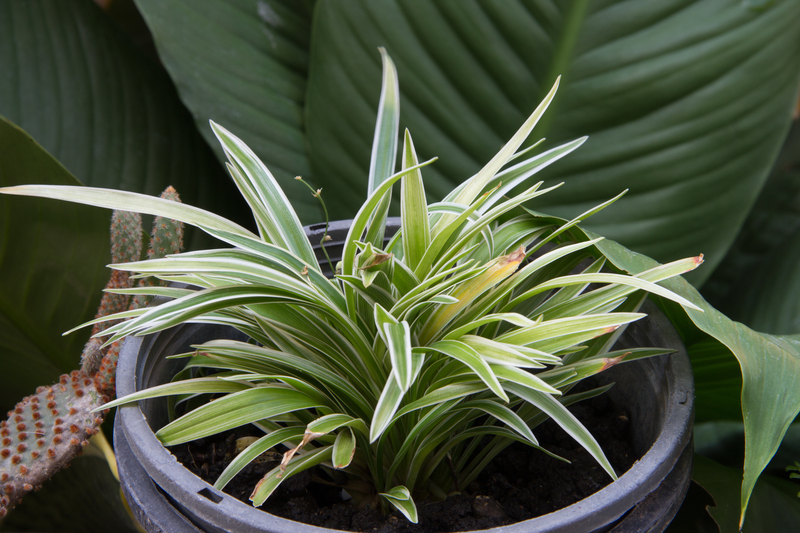Innovative methods to curb gusts in your garden space
Posted on 25/09/2025
Innovative Methods to Curb Gusts in Your Garden Space
Is wind wreaking havoc on your garden? Strong gusts can uproot plants, break stems, disperse seeds, and even erode your precious topsoil. Fortunately, there are creative and effective solutions available to transform your outdoor area into a serene sanctuary. This comprehensive guide delves into innovative methods to curb gusts in your garden space -- so you can cultivate a lush, thriving landscape protected from the wind's relentless force.

Understanding Wind Impact in Garden Spaces
Before applying solutions, it's vital to understand how wind gusts affect your garden. Persistent wind can:
- Dry out soil and plants by increasing evaporation
- Break branches or topple plants
- Spread weeds and pests
- Cause soil erosion and nutrient depletion
- Make outdoor areas uncomfortable for relaxation or entertaining
If your garden faces strong winds, adopting innovative ways to curb gusty conditions can make all the difference in your landscaping success and enjoyment.
Creative Wind Barriers for Gardens
Living Windbreaks: Nature's Shield
One of the most natural methods to control gusts in your garden space is using living windbreaks. A strategically planted line of trees, shrubs, or tall grasses acts as a buffer, reducing wind speed and intensity.
- Hedgerows: Choose dense, multi-layered plantings such as privet, boxwood, or holly. These green fences offer year-round protection and habitat for wildlife.
- Tall ornamental grasses: Varieties like Miscanthus or pampas grass are visually appealing and effectively slow wind at lower elevations without blocking light or views.
- Mixed planting zones: Layering various plants of different heights can break wind at multiple levels, creating a gentler airflow throughout your space.
Architectural Solutions for Wind Control
For a more modern approach, integrate innovative structural elements into your garden landscape. These additions not only curb gusts but often double as stunning design features.
- Permeable fences: Instead of a solid wall, opt for slatted wood, louvered panels, or mesh fences. These designs let air escape slowly, reducing wind speed and turbulence on the downwind side.
- Gabion walls: Wire baskets filled with stones act as durable windbreaks while providing texture and a rustic-chic appeal. Their open structure dissipates gust energy efficiently.
- Decorative screens: Laser-cut metal or composite panels serve a dual function -- artfully filtering wind and adding modern flair.
- Retractable windbreak systems: Install motorized or manual retractable screens around patios. Adjust the barriers seasonally or for special occasions as needed.
Water Features as Wind Buffers
Water features are not just for aesthetics; they can play a surprising role in tampering garden winds:
- Ponds or pools at strategic locations slow down airflow and create a cooling effect, making your space more comfortable.
- Water walls or vertical fountains act as wind baffles, breaking up gusts while masking wind noise for a tranquil environment.
Advanced Planting Strategies to Minimize Gust Damage
Layering & Zoning Plantings
A key tip to reduce gust damage in your garden is to layout your garden in layers:
- Windward layer: Plant robust, wind-tolerant species on the outermost edges -- think conifers, junipers, or sturdy shrubs.
- Intermediate buffer: Use medium-height plants or hedges to filter softer breezes.
- Protected inner zone: Grow delicate flowers, vegetables, or seating areas in the windshadow created by outer barriers.
Ground Covers for Soil Protection
Soil erosion is a typical consequence of unmitigated wind. Consider these innovative plant-based ground covers:
- Creeping thyme, sedum, and clover -- These low-growing covers lock in soil, increase biodiversity, and are visually stunning.
- Mulching techniques -- Layer organic mulch to anchor soil and insulate plant roots from drying winds.
Innovative Materials and Technologies for Wind Reduction
Geo-textiles and Plant Protection Fabrics
Garden technology has come far. Geo-textiles are modern mesh fabrics that wrap around vulnerable young trees or crop plots, offering wind and frost protection while letting sunlight and water pass through.
- Row covers: Lightweight floating row covers stabilize ambient temperature and protect against gusts throughout growing seasons.
- Wind nets: Heavy-duty netting installed around raised beds or garden perimeters efficiently reduces wind speed and prevents plant breakage.
Innovative Shading and Barrier Materials
Certain advanced materials not only shield from sun but can also serve as wind baffles:
- Shade sails: High-tensile fabrics stretched over seating or planting zones catch and redirect wind, creating protected pockets without full enclosure.
- Recycled plastic windbreaks: Eco-friendly and durable, these interlocking panels are designed for easy installation and customizable heights and lengths.
Strategic Use of Hardscaping
Thoughtful hardscaping can have a major impact on lessening wind disturbance:
- Rock gardens: Boulders and rock groupings disrupt wind patterns, stabilize soil, and serve as attractive features.
- Raised beds with wind walls: Use stone, wood, or composite windbreaks integrated into raised beds to protect delicate vegetables and herbs.
Designing for Airflow: Smart Garden Planning
Analyzing Wind Direction and Garden Topography
Every garden is unique. The most effective ways to curb gusts in your garden start with a site analysis:
- Observe and record predominant wind directions at different times of the year.
- Assess terrain features that may amplify or block wind, such as hills, valleys, and existing structures.
- Sketch a wind map to visualize high-risk areas that need extra protection.
Use this information to plan the placement of barriers, windbreaks, and sensitive planting zones.
Creating Microclimates with Structures
By compartmentalizing your garden, you can create cozy microclimates:
- Use pergolas, trellises, or lattice screens to partially enclose patios or dining areas, cutting strong winds while still allowing light and breezes.
- Arrange outbuildings, storage sheds, or greenhouses as natural wind buffers for more exposed garden areas.
Embracing Technology: Smart Solutions for Gust Management
Wind-Powered Garden Devices
Believe it or not, you can even harness the wind to help minimize its adverse effects:
- Wind turbines: Install small garden turbines which, while generating clean energy, act as a subtle wind disruption point, lowering wind speeds downwind.
- Wind spinners, kinetic art, and mobile sculptures -- break up airflow visually and physically, reducing straight-line gust impacts and adding dynamic artistry to your yard.
Weather Monitoring Systems
Modern weather stations or smart garden sensors provide up-to-the-minute data on wind speed, direction, and duration. Use apps to receive alerts or adjust retractable screens and covers remotely, ensuring optimal protection for your plants and outdoor furnishings at all times.
Seasonal and Maintenance Considerations
Seasonal Adjustments
Gusty conditions change with the seasons, so update your wind-curbing strategies accordingly:
- Spring/Summer: Focus on living windbreaks, shade solutions, and soil moisture retention.
- Autumn/Winter: Reinforce barriers, use burlap wraps, and protect roots with added mulch.
Maintaining Windbreaks and Structures
For long-term results:
- Prune and shape trees or hedges annually to ensure dense growth and structural strength.
- Inspect and repair screens, nets, and fences after major storms or seasonal transitions.
- Refresh mulch and ground covers as needed to guarantee soil stability.
Eco-Friendly and Sustainable Gust Management
Opt for environmentally conscious options wherever possible:
- Repurpose old pallets, doors, or windows into charming, wind-resistant garden partitions.
- Use non-toxic paints, stains, and recycled materials for fences and barriers.
- Choose native or drought-tolerant species for windbreak plantings to conserve water and ensure resilience.

Frequently Asked Questions: Managing Gusts in Your Garden
What is the most effective way to stop strong winds in the garden?
A combination of living windbreaks (trees and shrubs), hard barriers, and strategic garden layout is the most effective solution. Layering these methods creates a synergistic effect, diffusing and slowing wind gusts while enhancing garden aesthetics.
Can I DIY my own windbreaks?
Absolutely! Many innovative wind barriers can be created with reclaimed wood, upcycled materials, or by planting fast-growing screenings like willow or bamboo. Even strategic placement of large containers or trellises offers immediate gust deflection.
Are temporary solutions effective?
Yes. Temporary windbreak netting or fabric screens are a great option for short-term projects, new plantings, or special events when you need immediate shelter.
Conclusion: Enhance Your Garden's Serenity by Curbing Gusts Creatively
Taming the wind doesn't require giving up on your garden dreams. With a little observation, smart design, and a mixture of natural and technological solutions, you can craft a space that's protected from gusts yet open to fresh air and sunshine. By adopting innovative methods to curb gusts in your garden space, you safeguard your plants, soil, and comfort, making your garden a true outdoor haven.
- Key Tips Recap: Analyze your site, blend living and architectural windbreaks, try advanced fabrics, and keep sustainability in mind.
- Don't be afraid to experiment -- every garden is unique, and new materials or designs pop up each season!
Ready to reclaim your garden from unruly gusts? Implement these strategies, and let your outdoor sanctuary flourish -- tranquil, comfortable, and wind-wise!



